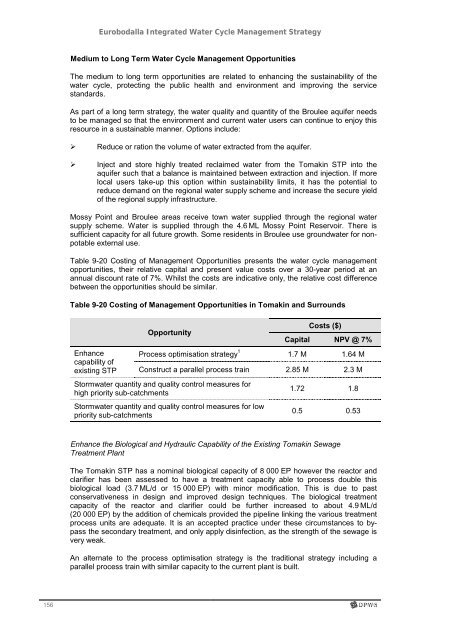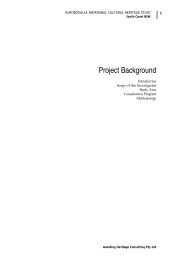Eurobodalla Integrated Water Cycle Management Strategy
Eurobodalla Integrated Water Cycle Management Strategy
Eurobodalla Integrated Water Cycle Management Strategy
Create successful ePaper yourself
Turn your PDF publications into a flip-book with our unique Google optimized e-Paper software.
156<br />
<strong>Eurobodalla</strong> <strong>Integrated</strong> <strong>Water</strong> <strong>Cycle</strong> <strong>Management</strong> <strong>Strategy</strong><br />
Medium to Long Term <strong>Water</strong> <strong>Cycle</strong> <strong>Management</strong> Opportunities<br />
The medium to long term opportunities are related to enhancing the sustainability of the<br />
water cycle, protecting the public health and environment and improving the service<br />
standards.<br />
As part of a long term strategy, the water quality and quantity of the Broulee aquifer needs<br />
to be managed so that the environment and current water users can continue to enjoy this<br />
resource in a sustainable manner. Options include:<br />
Reduce or ration the volume of water extracted from the aquifer.<br />
Inject and store highly treated reclaimed water from the Tomakin STP into the<br />
aquifer such that a balance is maintained between extraction and injection. If more<br />
local users take-up this option within sustainability limits, it has the potential to<br />
reduce demand on the regional water supply scheme and increase the secure yield<br />
of the regional supply infrastructure.<br />
Mossy Point and Broulee areas receive town water supplied through the regional water<br />
supply scheme. <strong>Water</strong> is supplied through the 4.6 ML Mossy Point Reservoir. There is<br />
sufficient capacity for all future growth. Some residents in Broulee use groundwater for nonpotable<br />
external use.<br />
Table 9-20 Costing of <strong>Management</strong> Opportunities presents the water cycle management<br />
opportunities, their relative capital and present value costs over a 30-year period at an<br />
annual discount rate of 7%. Whilst the costs are indicative only, the relative cost difference<br />
between the opportunities should be similar.<br />
Table 9-20 Costing of <strong>Management</strong> Opportunities in Tomakin and Surrounds<br />
Costs ($)<br />
Opportunity<br />
Capital NPV @ 7%<br />
Process optimisation strategy 1<br />
Enhance<br />
capability of<br />
1.7 M 1.64 M<br />
existing STP Construct a parallel process train 2.85 M 2.3 M<br />
Stormwater quantity and quality control measures for<br />
high priority sub-catchments<br />
Stormwater quantity and quality control measures for low<br />
priority sub-catchments<br />
1.72 1.8<br />
0.5 0.53<br />
Enhance the Biological and Hydraulic Capability of the Existing Tomakin Sewage<br />
Treatment Plant<br />
The Tomakin STP has a nominal biological capacity of 8 000 EP however the reactor and<br />
clarifier has been assessed to have a treatment capacity able to process double this<br />
biological load (3.7 ML/d or 15 000 EP) with minor modification. This is due to past<br />
conservativeness in design and improved design techniques. The biological treatment<br />
capacity of the reactor and clarifier could be further increased to about 4.9 ML/d<br />
(20 000 EP) by the addition of chemicals provided the pipeline linking the various treatment<br />
process units are adequate. It is an accepted practice under these circumstances to bypass<br />
the secondary treatment, and only apply disinfection, as the strength of the sewage is<br />
very weak.<br />
An alternate to the process optimisation strategy is the traditional strategy including a<br />
parallel process train with similar capacity to the current plant is built.

















